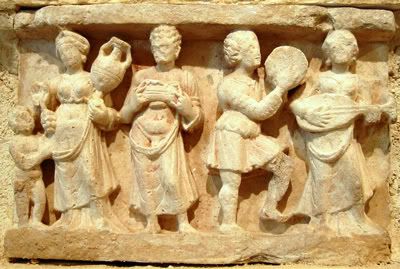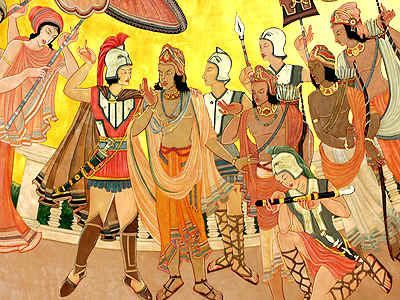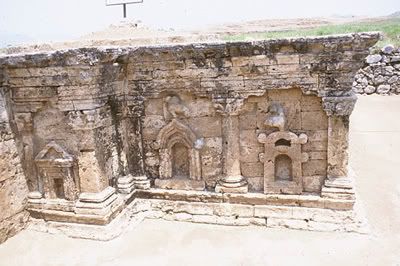
A Symposium at Alexandria on the Indus

Scene: The House of Bassarodoros, Situated in Alexandria on the Indus. The wealthy Bassarodoros celebrating his profits from the silk trade and for his own amusement and that of his guests, had invited three guests who each followed one popular philosophies from the land beyond the Indus. They were Shvetashvatara – a Brahmin who sought the secrets of the divine, Dharmaraksita – A monk of the Buddhists, and Siha – a follower of the doctrine of Mahavira.
The symposium began to get underway as the sun was setting and after libations were offered, a hymn had been sung to Bassareus, and all the usual ceremonies had been carried out, Bassarodoros rose and addressed his guests.
Bassarodoros: Friends, I have called these three esteemed followers of philosophy here because I seek to know what the self consists of since I have heard much debate on the subject recently in the marketplace. As Siha has traveled the greatest distance to our humble house, I shall ask him first: What is the self?
Siha: O noble Bassarodoros, the Self is the Self. It is an independent finite entity and it is immortal, it is the 'jiva'. The jivas inhabits all things from the rocks and animals to men and the gods. It is combined with the ajiva material and subtle things such as karma and thus is kept imprisoned in the grievous cycle of birth and death and birth... It is only by realizing that one is a jiva and extinguishing all karma can one gain entrance into Siddha-loka, the abode of the liberated to experience bliss for eternity.
Bassarodoros: Interesting... Some of what you speak of sounds like the doctrine of the followers of Orpheus.
Siha: I am afraid that I am not familiar with those of whom you speak.
Bassarodoros: Oh, it is just a movement that is native to my homeland that also speaks of the cycle of death and rebirth and follows a vegetarian diet but attributes the soul to the god Dionysus and the material body to the Titans, who are a bit like your Asuras, as explained in their myths. They seek liberation through purification, asceticism, and knowing how to navigate through Hades, the land of the dead.
Siha: From what you speak they sound like they may have heard the teachings of one of the previous Tirthankaras before Mahavira and have over time strayed from the true path of liberation.
Bassarodoros: Perhaps, though I personally do not find your proposition likely.
Shvetashvatara: O noble Bassarodoros, may I speak?
Bassarodoros: Yes, you may.
Shvetashvatara: Noble Bassarodoros, the followers of Mahavira are deluded about the the nature of the Self. The Self is not an individual entity that is an illusion, the True Self is one with God. Siha, even your own teaching hints at this truth, but because of ignorance you cannot see the truth.
Siha: What do you mean?
Shvetashvatara: I have heard some of your followers speak of God, and when I have questioned them they say that by this they mean your jinas and other liberated jivas who are indistinguishable from one another and so are called as a whole 'God'. Can you not see that all of your jivas share a single essence? And that essence is identical to God, or as we call the supreme reality, Brahman?
Siha: O wise Shvetashvatara, I believe that it is you who is deluded by your over philosophizing. Just because things have an identical nature does not make them the same being, perhaps you would say that there is only one human because all humans are alike but clearly when I go out into the city I have to navigate through crowds of humans and not just walk by one.
Shvetashvatara: You still do not understand. The crowds, the city, each human, all are illusions and it is only through ignorance that one does not understand that at the basic level all are the same and that the True Self, the Atman, is one with Brahman. Brahman pervades all reality like salt pervades in the waters of the great sea. It is only through our own ignorance of our true nature as one with Brahman that we exist thinking we are apart from him and continue through various lives and bodies. It is not you who sees, hears, acts, and feels – that is Brahman who is the true seer, the true hearer, the true actor, and the true feeler.
At this point the aged Dharmaraksita began chuckling.
Bassarodoros: Wise Dharmaraksita, is there something you wish to say?
Dharmaraksita: Oh yes, noble Bassarodoros.
Bassarodoros: Then speak, I especially look forward to what you have to say as you are Yona (Greek) yourself and much has been said about you and your illustrious pupil Nagasena in the marketplace and in some Yona lands statues and devotions to your 'Buddha' have become more popular than those to the god Shiva.
Dharmaraksita: Oh noble Bassarodoros, I chuckle because both Shvetashvatara and Siha are deluded by ignorance. The Self which they talk of does not exist, it is merely a construct – it is what we call the aggregates when they are together in a shape which we recognize. Take for example a chariot, despite what the so called sages say, even the great sages of Hellas, it is just a simple collection of parts.
Bassarodoros: What do you mean?
Dharmaraksita: Look at a chariot and then take it apart. One is left with merely a collection of parts which includes the wheels, the axel, and other things. Surely you would not call this collection of parts a chariot, would you noble Bassarodoros?
Bassarodoros: No, I would not.
Dharmaraksita: Then if the chariot is a thing, then where did it go? Thus it didn't truly exist in the first place.
Siha: But wise Dharmaraksita, I have heard some of the followers of the Buddha say that the self does exist as a Person. They call themselves the Pudgalavadins.
Dharmaraksita: Oh them, they have fallen away from the path to liberation and have been misled by deluded teachers. Any argument coming from their camp does not represent the true teachings of the enlightened one. As I have shown through use of example there is no self as there is no chariot.
Siha: When you speak of the self here, you seem to be speaking of the phenomenal self of every day terms and not the jiva or the even the Atman of the Brahmins.
Dharmaraksita: Nonsense, even if one part of the self is identified with the Jiva or the Atman that piece itself can be broken down into various parts like a wheel of a chariot which can be broken down into spokes, rim, and other things. These pieces in turn can be broken down to an infinite level and one would find that there is only emptiness – which is everything.
Shvetashvatara: How can you see nothing there at the ultimate ground of being?! That is the true reality itself and it is the essence of Brahman which is all. It is the seer, the hearer, the thinker, and doer of all action.
Dharmaraksita: You are very wise Shvetashvatara, but you cannot see past the last delusion of all. The attribution of an 'essence' to the ultimate ground of being. It is empty of and beyond all concepts including the concept of essence. There is no seer, no hearer, no thinker, and no doer. There is only seeing, hearing, thinking, and doing. There is only emptiness itself and when one truly knows this one attains nirvana and no longer dies or is reborn.
Siha: AH! But then were does your Buddha go? And what is reborn?
Dharmaraksita: Shakyamuni exists still but also does not still exist – his mindstream has been extinguished and cannot lead to the creation of another being but because he has dissolved away and one cannot identify him anymore does not mean he does not "exist". The mindstream is a process, it is like a flame in that it exists through the skandhas as fire burns from wood, oil, or wax. The flame itself may be transferred from one body to the next as one may light a candle with a candle – there is no essence or soul passed on it is simply the continuation of a process. Nirvana is the extinguishing of this process – say you let a candle burn until it has run out of wax to burn, the flame then goes out. Can you show me where the flame went?
Siha: No, I cannot.
Dharmaraksita: Then that is your answer as to where Shakyamuni went. He is neither here nor there. He did not have an independent essence, no being does, there are only processes in the emptiness.
Siha: I can see what both you and the wise brahmin say, but I still feel that I am still on the most correct path. We are perhaps like the blind men who sought to describe an elephant. Our differences are perhaps do to our different perspectives on the ultimate and by the limitations of the human mind and speech we only possess parts of the picture. This is known in my tradition as the doctrine of Manysidedness.
After this the debate on the nature of the self subsided and most of the guests descended into reveilles and discussed other matters. Siha and Shvetashvatara left not long after the discussion had ended and Dharmaraksita was beginning to leave as well when Bassarodoros approached him.
Bassarodoros: Oh wise Dharmaraksita, I wish to congratulate you for you are a great sage, and your explanation of the self made the most sense. I can now see why more and more Yona everyday are following the path of the Buddha. That the mindstream is a process – one that does not have a stable essence makes excellent sense to me as I have many times wondered how the 'soul' could be eternal if it was always changing due to changes in one's thinking or conditions. That emptiness is the ground of all beings makes more sense than saying that there is an essence to it since that is a concept – I can understand the Brahmin's point of view but seeing the ground of being as something more akin to the empty churning Khaos which Hesiod described makes much more sense. I can see now how the gods and other beings then arose as processes out of the Khaos through your wise teachings. I now wish to learn more of the Buddhist path.
Dharmaraksita then smiled and instructed Bassarodoros throughout the night and on into the morning.

Bibliography
Conze, Edward. Ed. Buddhist Scriptures. London: Penguin Books. 1997.
Gitana. “Reincarnation: An Orphic Perspective”. The Hellenion Proto-Demos tes Hagnes Persephones. http://persephones.250free.com/orphic-reincarnation.html. (accessed October 16, 2007).
Gitana. “A Retelling of an Orphic Cosmogony”. The Hellenion Proto-Demos tes Hagnes Persephones. http://persephones.250free.com/orphic-cosmogony.html. (accessed October 16, 2007).
Embree, Ainslie T. Ed. The Hindu Tradition: Readings in Oriental Thought. New York: Vintage Books. 1972.
Embree, Ainslie T. Ed. Sources of Indian Tradition. Vol I. 2nd ed. New York: Columbia University Press. 1988.
Eknath, Easwaran. Trans. The Dhammapada. London: Nilgiri Press. 1985.
Flood, Gavin. An Introduction to Hinduism. UK: Cambridge University Press. 1996.
Hinnells, John R. Ed. The New Penguin Handbook of Living Religions. London: Penguin Books. 1997.
Holt, Frank M. Thundering Zeus: The Making of Hellenistic Bactria. Berkeley: University of California Press. 1999.
Marshall, John. The Buddhist Art of Gandhara. London: Cambridge University Press. 1960.
Narain, A. K. The Indo-Greeks. New York: Oxford University Press. 1957.
Rahula, Walpola. What the Buddha Taught. New York: Grove Press. 1974.
Rice, Tamara Talbot. Ancient Arts of Central Asia. New York: Frederick A. Praeger inc. 1965.
Williams, Paul and Anthony Tribe. Buddhist Thought: A Complete Introduction to the Indian Tradition. New York: Routledge. 2000.

No comments:
Post a Comment